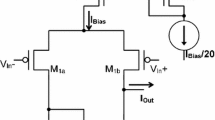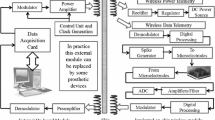Abstract
In this paper, a low noise high gain CMOS amplifier for minute nerve signals is presented. The amplifier is constructed in a fully differential topology to maximize noise rejection. By using a mixture of weak- and strong inversion transistors, optimal noise suppression in the amplifier is achieved. A continuous-time current-steering offset-compensation technique is utilized in order to minimize the noise contribution and to minimize dynamic impact on the amplifier input nodes. The method for signal recovery from noisy nerve signals is presented. A prototype amplifier is realized in a standard digital 0.5 μm CMOS single poly, n-well process. The prototype amplifier features a gain of 80 dB over a 10 kHz bandwidth, a CMRR of more than 87 dB and a PSRR greater than 84 dB. The equivalent input referred noise in the bandwidth of interest is 4.8 nV/\(\sqrt {{\text{Hz}}} \). The amplifier power consumption is 275 μW, drawn from a power supply; V DD = −V SS = 1.5 V.
Similar content being viewed by others
References
M. K. Haugland, Natural Sensory Feedback for Closed-loop Control of Paralyzed Muscles. Ph.D. thesis, University of Aalborg, 1994.
A. Lickel, Restoration of Lateral Hand Grasp in a Tetraplegic Patient Applying Natural Sensory Feedback. Ph.D. thesis, University of Aalborg, 1998.
G. Gudnason, E. Bruun, and M. Haugland, “An implantable mixed analog/digital neural stimulator circuit,” in Proc. IEEE ISCAS, Orlando, FL, May 30–June 2, 1999, pp. 375–378.
K. Papathanasiou and T. Lehmann, “An implantable CMOS nerve signal conditioning system for recording nerve signals with cuff electrodes,” in Proc. IEEE ISCAS, Geneva, May 28–31, 2000, pp. 281–284.
K. G. Lamb, S. J. Sanchez, and W. T. Holman, “A low noise operational amplifier design using subthreshold operation,” in Proc. IEEE Midwest Symp. Circuits Syst., Notre Dame, IN, August 9–12, 1998, pp. 35–38.
J. Chang, A. A. Abidi, and C. R. Viswanathan, “Flicker noise in CMOS transistors from subthrehold to strong inversion at various temperatures.,” IEEE Trans. On Electron Devices 41, pp. 1965–1971, 1994.
C. C. Enz, “The EKV model: A most model dedicated to low-current and low-voltage analogue circuit design and simulation,” in Low-Power HF Microelectronics A Unified Approach, Machado, G. A. S. (ed.), IEE, 1996, pp. 247–299.
A. Bakker, K. Thiele, and J. H. Huijsing, “A CMOS nested-chopper instumentation amplifier with 100-nV offset.,” IEEE Journal of Solid-State Circuits 35(12), pp. 1877–1883, 2000.
C. C. Enz and G. C. Temes, “Circuit techniques for reducing the effects of op-amp imperfections: Autozeroing, correlated double sampling, and chopper stabilization,” Proc. of the IEEE 84(11), pp. 1584–1614, 1996.
G. Gudnason, J. H. Nielsen, E. Bruun, and M. Haugland, “A distributed transducer system for functional electrical stimulation,” in Proc. ICECS, 2001, pp. 397–400.
Author information
Authors and Affiliations
Rights and permissions
About this article
Cite this article
Nielsen, J.H., Lehmann, T. An Implantable CMOS Amplifier for Nerve Signals. Analog Integrated Circuits and Signal Processing 36, 153–164 (2003). https://doi.org/10.1023/A:1024422319674
Issue Date:
DOI: https://doi.org/10.1023/A:1024422319674




